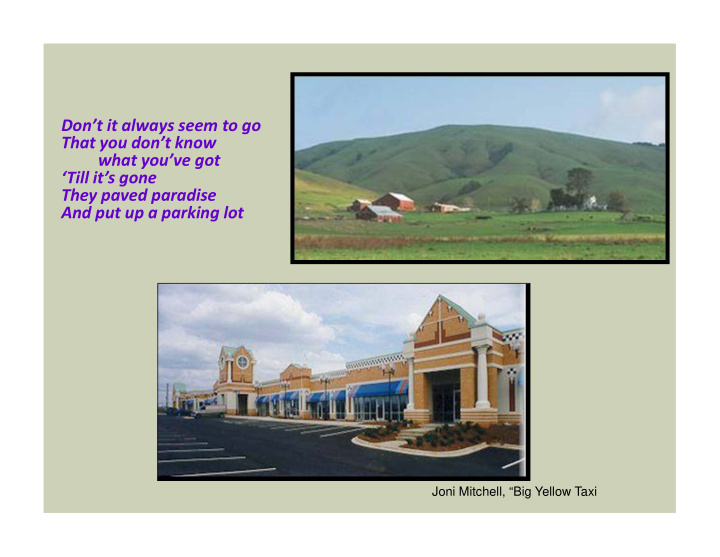



Don’t it always seem to go That you don’t know what you’ve got ‘Till it’s gone They paved paradise And put up a parking lot Joni Mitchell, “Big Yellow Taxi
KNOW WHAT YOU HAVE Hist Histor oric ic Pr Prop oper erty ty RESOURCE MANAGEMENT CULTURAL Sur Surveys s BASIC LUCINDA WOODWARD OFFICE OF HISTORIC PRESERVATION NOVEMBER 17, 2015
Provide tangible links to our historical and cultural heritage HIST HISTORIC ORIC RESOUR RESOURCE CES ARE ARE Help create special character and IMPORT IMPORTANT ANT COMMUNITY COMMUNIT Y identity AND PARK AND P RK ASSET ASSETS Represent investments in energy, time, money and raw materials Maintenance, rehabilitation and adaptive reuse of historic creates economic benefits locally and are sustainable and green practice
HISTORIC RESOURCES = A$$ET$ WISE MANA WISE MANAGEMENT OF GEMENT OF ASSETS ASSETS INV INVOLVES: ES: Respecting their v specting their value lue Prolonging Prolonging their lif their life e Use them ef Use them effectiv ctively ely Ac Acting i in a a s stewar ewardshi hip role role Califor nia Office of Histori c Preser vation
HOW DO YOU KNOW IF SOMETHING IS A HISTORICAL RESOURCE?
HISTORIC RESOURCE?
HISTORIC RESOURCE?
HIST HISTORIC ORIC CONTEX CONTEXTS THERE’S NO PROGRAM SURVEY SUR EYS WITHOUT A PLAN HIST HISTORIC ORICAL AL RESO RESOUR URCE CES
TRANSFORMATION TEAM GOAL Cultural Resource data management is a core program that uses innovative means to meet regulatory and professional standards in providing required data to achieve our stewardship mission .
TRANSFORMATION TEAM RESOURCES COMMITTEE RECOMMENDATIONS Use innovative data Identify gaps in the gathering, surveying, inventory data and recordation system-wide strategies Update existing Ongoing program to inventory data re-evaluate and Link building and revisit inventory archaeological data as surveys to eligibility environmental evaluation program conditions
Historic Contexts Tell the stories that explain how, when, and why the built environment developed or looks the way it does.
HISTORIC CONTEXTS What They Are What They Are Not Provide a framework for making A chronological recitation of decisions about the identification and “important” events evaluation of historic properties Focus on themes A list of “famous” folks Focus on time period A comprehensive park or community history Focus on geographical area A writing exercise to demonstrate Identify the property types associated with the context exemplary research efforts Identifies expected character defining features Sets thresholds for integrity
WHAT ARE SURVEYS? Systematic process for Gathering information about a park’s or community’s resources. Identifying and Evaluating the quantity Windshield and quality of historical resources Reconnaissance Intensive Results in an Inventory Sampling
SURVEYS PROVIDE CLUES What resources exist? Districts? Individual? Where are the resources located? What are their character defining features ? Why are they significant ? Have they retained integrity ? How does each need to be considered in planning ? Surveys are a snapshot in time, so Revisit , Reevaluate, Update Inve n tory
EV EVAL ALUATION OF RESOUR TION OF RESOURCES CES Pr Process ocess of Asking Questions Asking Questions Getting Answ Ge tting Answer ers Making an Analysis Making an Analysis Reaching a aching a Facts-based cts-based Conclusion Conclusion Making Def Making Defensible Findings nsible Findings
SURVEYS PROVIDE DIRECTION FOR PRESERVATION ACTIVITIES General Plans Heritage Tourism Rehabilitation Restoration Project Planning Adaptive Reuse Design Guidelines Distaster Planning & Response Registration Environmental Review Interpretive Programs Infrastructure Projects
PROPERTY TYPES
HISTORICAL RESOURCES BUILDINGS
HIST HISTORIC ORICAL AL RESOUR RESOURCE CES STRUCTURES STRUCTURES
HISTORICAL RESOURCES OBJECTS
HISTORICAL RESOURCES SITES
HISTORICAL RESOURCES DISTRICTS
CRITERIA FOR SIGNIFICANCE
EVENT EVENT OR OR BR BROAD D PA PATTERNS OF OF HIST HISTOR ORY
ASSOCIATED WITH PERSONS
SIGNIFIC SIGNIFICANT DES DESIGN GN OR OR WO WORK O OF A A MASTE MASTER
INFORMATION POTENTIAL
MORE ON SIGNIFICANCE
THEY C THEY CAN N BE BE SIGNIFIC SIGNIFICANT ANT BECA BECAUSE USE THEY THEY REPRESENT REPRESENT CUL CULTURAL URAL DIVERSI DIVERSITY
THEY CAN BE SIGNIFICANT AS IMPORTANT EXAMPLES OF THE RECENT PAST
THEY CAN THEY CAN BE BE IMPOR IMPORTANT T CUL CULTUR URAL LANDSCAPES LANDS ES OR OR TRADITIO TRADITIONAL CUL CULTUR URAL PROPERTIES PROPERTIES
NATIONAL- STATE PARK COOPERATIVE PROGRAM AND THE CIVILIAN CONSERVATION CORPS IN CALIFORNIA STATE PARKS 1933-1942 ( J U N E 2 0 0 9 )
HISTORIC RESOURCE STUDY FOR BIG BASIN REDWOODS STATE PARK ( J A N U A RY 2 0 0 9 )
HISTORIC RESOURCES OF BIG BASIN REDWOODS STATE PARK ( DECEMBER. 2010 )
BIG BASIN REDWOODS STATE PARKS HEADQUARTERS ADMINISTRATION BUILDING NATIONAL REGISTER NOMINATION (2015)
FO FOR M MORE INF INFORMATIO ION
FOR MORE INFORMATION
FOR MORE INFORMATION California Office of Historic Preservation www.parks.ca.gov Lucinda Woodward Supervisor, Local Government and Environmental Compliance Lucinda.woodward@parks.ca.gov 916-445-7028
Recommend
More recommend